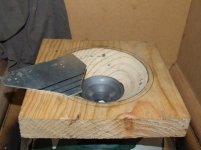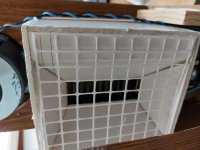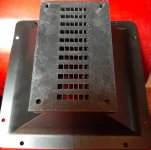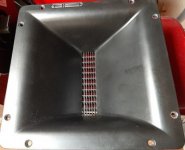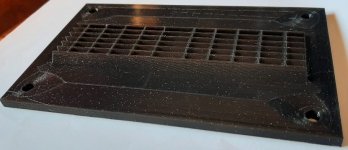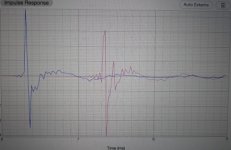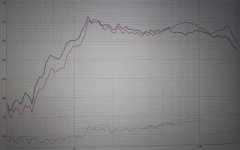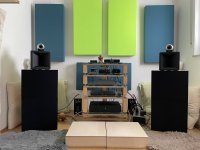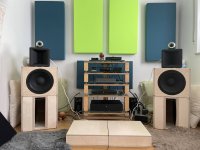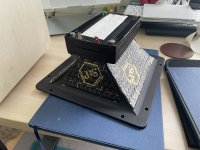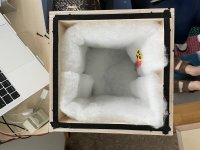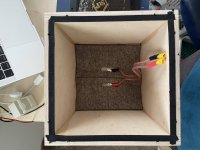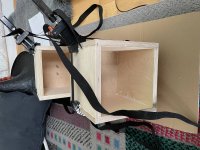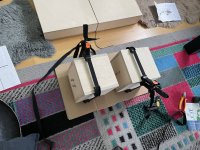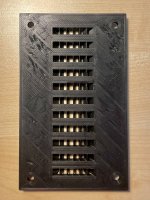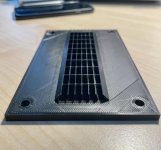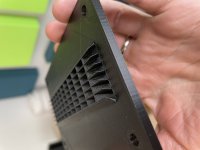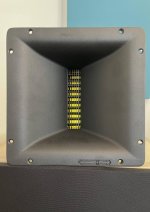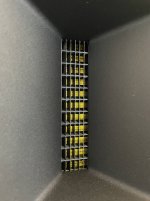I used aluminium backed bitumen at one point, shown here partially intact. At the time I was using a steel lamp shade for the body..
So, wait I am not sure what I am seeing. You were building a conical horn using a lamp shade?
It works in dipole, without rear camera. And also if you put a large rear camera. I have tried one about 10 times larger than Beyma's and stuffed with polyester wool. And it works too. I don't know if that one you put is good.
Thank you. Could you show me what you used? I think I will use normal polyester wool but that one tends to be rather low density if it is not made into a felt.
If I leave it open as a dipole, I want to protect the rear, from stuff to enter and damage the kapton membrane. Maybe just a piece of acoustic cloth fixed with tape, for the moment.
The Beyma waveguide is made of Aluminium and it has some resonance. Do you think that dampening it would help? Like gluing bitumen sheets to its external surface (on the back of course)?
In my opinion the coloration is due to the fact that it is horn of constant directivity and not to material resonances. Y like the tractrix.
This Beyma waveguide is very well made and robust. And its coloration is much less than other constant directivity trumpets that I have done with other tweeters.
I don't think you need dampening or gluing bitumen sheets to its external surface.
But it is something that you can try and tell the result.
I'm envious that you can put images and I can't. It must be that we have a quota of images to put and I have exceeded it. Or something like that.
I can´t made a nice thread with lots of graphical explanations.
This is interesting. Would you take a screenshot of the error message you get and I will look into it for you..I'm envious that you can put images and I can't. It must be that we have a quota of images to put and I have exceeded it. Or something like that.
I have installed the filters in the Beyma waveguide. The results are quite stunning, I must say. I had problems with sibilants before: gone. This must because the 8khz resonance has been tamed. At higher sound pressure I was experiencing some listening fatigue: now gone as well. This must be because the distortion has been tamed, too. Transients were precise before as well, but now they are sharp as with some high end headphones. Again, probably due to the taming of the resonance and therefore of the impulse post-ringing.
The sound is also slightly more forward. Probably because the 2-5khz range has been lifted a bit, by a couple of Dbs. But it is not of the in-your-face quality, as with some large horns.
Anybody that is serious about using the TPL-150H (and, I guess, the TPL-200H( should remove the back chamber and felt (replace the latter with some gauze, at least, to prevent insects to enter the transducer), and place this acoustic filter between the horn and body of the TPL. The effort is minimal and the sq gain is really appreciable. The work done by Luis is nothing short of excellent.
I was wondering if one now could cross it lower. Such as 1.4Khz with a very steep slope (4th order). The distortion numbers seem to suggest it would be possible, without sq degradation.
The sound is also slightly more forward. Probably because the 2-5khz range has been lifted a bit, by a couple of Dbs. But it is not of the in-your-face quality, as with some large horns.
Anybody that is serious about using the TPL-150H (and, I guess, the TPL-200H( should remove the back chamber and felt (replace the latter with some gauze, at least, to prevent insects to enter the transducer), and place this acoustic filter between the horn and body of the TPL. The effort is minimal and the sq gain is really appreciable. The work done by Luis is nothing short of excellent.
I was wondering if one now could cross it lower. Such as 1.4Khz with a very steep slope (4th order). The distortion numbers seem to suggest it would be possible, without sq degradation.
I have installed the filters in the Beyma waveguide. The results are quite stunning, I must say. I had problems with sibilants before: gone. This must because the 8khz resonance has been tamed. At higher sound pressure I was experiencing some listening fatigue: now gone as well. This must be because the distortion has been tamed, too. Transients were precise before as well, but now they are sharp as with some high end headphones. Again, probably due to the taming of the resonance and therefore of the impulse post-ringing.
The sound is also slightly more forward. Probably because the 2-5khz range has been lifted a bit, by a couple of Dbs. But it is not of the in-your-face quality, as with some large horns.
Anybody that is serious about using the TPL-150H (and, I guess, the TPL-200H( should remove the back chamber and felt (replace the latter with some gauze, at least, to prevent insects to enter the transducer), and place this acoustic filter between the horn and body of the TPL. The effort is minimal and the sq gain is really appreciable. The work done by Luis is nothing short of excellent.
I was wondering if one now could cross it lower. Such as 1.4Khz with a very steep slope (4th order). The distortion numbers seem to suggest it would be possible, without sq degradation.
I'm very interested in doing this. How did you make the filters? I'm guessing a 3D printer. Did you made the 3D model yourself of received/downloaded it?
I'm already happy with TPL-150H in dipole, and I do notice some of the artifacts you described. These filters sound like the way to go!
So, a little update to my build.
I built two little cubes, 230 mm per side, for the Beymas, out of 18mm MDF plywood. I do not have a picture for it, but behind the Beyma, glued to the rear panel, there is a vertical wooden strip with a triangular section, to deflect the waves to the sides, as well as two further such strips at the edges where the rear panel meets the sides. The strip is something like this.
The rear is then covered with 1cm thick medium density felt, and then the box is also lined with sonofil. The horn itself of the TPL-150 is further dampened with alubutil, because this is DIY and therefore it is all about the fun of overengineering
In the attached pictures you can admire my "chicas" in all their glory: naked and dressed. (This is joint work with Ashareth.)
I built two little cubes, 230 mm per side, for the Beymas, out of 18mm MDF plywood. I do not have a picture for it, but behind the Beyma, glued to the rear panel, there is a vertical wooden strip with a triangular section, to deflect the waves to the sides, as well as two further such strips at the edges where the rear panel meets the sides. The strip is something like this.
The rear is then covered with 1cm thick medium density felt, and then the box is also lined with sonofil. The horn itself of the TPL-150 is further dampened with alubutil, because this is DIY and therefore it is all about the fun of overengineering
In the attached pictures you can admire my "chicas" in all their glory: naked and dressed. (This is joint work with Ashareth.)
Attachments
Last edited:
So, a little update to my build.
I built two little cubes, 230 mm per side, for the Beymas, out of 18mm MDF plywood. I do not have a picture for it, but behind the Beyma, glued to the rear panel, there is a vertical wooden strip with a triangular section, to deflect the waves to the sides, as well as two further such strips at the edges where the rear panel meets the sides. The strip is something like this.
The rear is then covered with 1cm thick medium density felt, and then the box is also lined with sonofil. The horn itself of the TPL-150 is further dampened with alubutil, because this is DIY and therefore it is all about the fun of overengineering
In the attached pictures you can admire my "chicas" in all their glory: naked and dressed. (This is joint work with Ashareth.)
Nice!
What are the tweeters above the TPLs and the xo point/slope you are applying?
Nice!
What are the tweeters above the TPLs and the xo point/slope you are applying?
The tweeters are Visaton TL-16H. Close to the best Fostex's if you only consider the very top frequencies (where any distortion is actually completely irrelevant).
There is no xo in the sense that there is no low pass on the Beyma, but I put a 2nd order high pass with f3 at roughly 16K on the Visaton. Since the TPL-150H starts decreasing naturally just before 14K when a dipole or in a large chamber, without the felt on the back and with the filter, this makes for a nice smooth response – as simulated with XSIM and may not be perfect, and I still have to measure. In order to combine the responses in a good way I actually used 0.56uF series and 0.33mH parallel (this is also what I had at home, LOL).
So the result is a two way system which is assisted at the extremities: an active Ripole for 17-60 Hz and for the 16K-35K the Visaton.
- Home
- Loudspeakers
- Multi-Way
- Acoustical notch filter for TPL-150
